Catholic Customs
 |
 |
 |
 |
 |
 |
 |
Bonfires on the Eve of St. John the Baptist
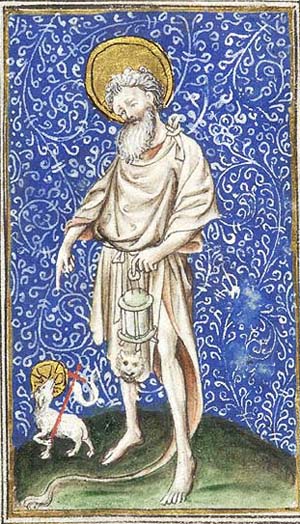
John the Baptist with his lantern pointing to Christ
The Nativity of St. John the Baptist is on June 24, which is around the Summer Solstice. From this day onward, daylight begins to decrease. How fitting it is that John who "must decrease" was born when the sun's light begins to diminish until Christmas. With Our Lord's birth, sunlight again begins to conquer over the night. The fact that June 24 is the longest day of the year led to many customs connected to the fullness of daylight.
Water and herbs
As with many of the great feasts, the Eve of the feast is considered blessed. In many places it is believed that hidden treasures lie in open places this night, that water from springs, seas, rivers and even dew brings blessings if one bathes in it, and that the herbs picked tonight have special healing properties.
Most likely because of St. John's work of baptizing in the Jordan, Catholic peoples, especially in Mexico, Spain and Portugal, decorated fountains and wells with flowers and ribbons. Portuguese peasants would bring the water back to their houses in lovely pitchers decorated with flowers.
Before dawn on June 23 when the dew is still on the ground, it is traditional to pick special herbs, especially green birch, long fennel, St. John's Wort, mugwort, plaintain, corn marigold, dwarf elder, yarrow, ivy, vervain, orpin and white lilies.
In England, these herbs were made into wreaths and garlands adorned with flowers and hung on the doors of houses along with glass oil lamps. Some of the herbs that were collected would be thrown into the St. John's fires to produce a pleasing scent and drive away demons. In Germany, these herbs would be brought to the church to be blessed at the morning Mass.
St. John's fires
Christ describes John the Baptist by saying that he was "a burning and a shining light" (Jn 5:35). For this reason, fires are lit on the eve of the feast in honor of the one who announced the true Light to the dark world. Some of these fires are large bonfires, others are torches thrown into the air, others are floating lanterns or flaming wheels sent rolling down hills with blessed candles inside. In many places fireworks are set off.

St. John's fire in Bretagne,
below, the custom revives in Poland
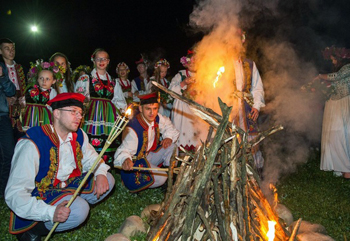
The fires were traditionally lit at the moment that the sun set, except for in the far Northern countries where the sun would not set on this night. St. John's fires were lit all over Christendom from Russia to South America on every mountaintop, hilltop, valley, seashore and fiord. In cities, old furniture would supply the fuel for fires that lit every street. How glorious is this tribute to the Saint outside of whom no greater born of woman exists.
In many places, these fires would be lit in a chain starting at one mountaintop or coast; then, the same flame was carried to other fires throughout a region.
In Catalonia, all of the village fires are lit from a fire started on the mountain of Canigó. From this fire lit in the evening, other torches are lighted and carried throughout the region, but first to Barcelona where the flame carrier is received with all due pomp by the city officials. After the ceremony, its flame is used to light various torches that are given to representatives of each district to light all the fires in the city.
Before the French Revolution, every man, woman and child – be he the King himself or the lowliest peasant – supplied some sort of fuel for the fire, even if it were only a tiny twig.
In the Place de Grêve in Paris, a "St. John's tree" was raised in the square. The King and his court would solemnly process to the erected tree and set it afire with a torch presented by the Prévôt. King Louis XV was the last King to light the "St. John's tree" in 1719 and attend the fireworks display that took place before the bonfire had entirely died down.
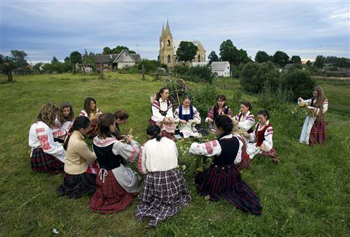
Girls in Belarus making wreaths for the St. John festival; below, festivities in Lithuania
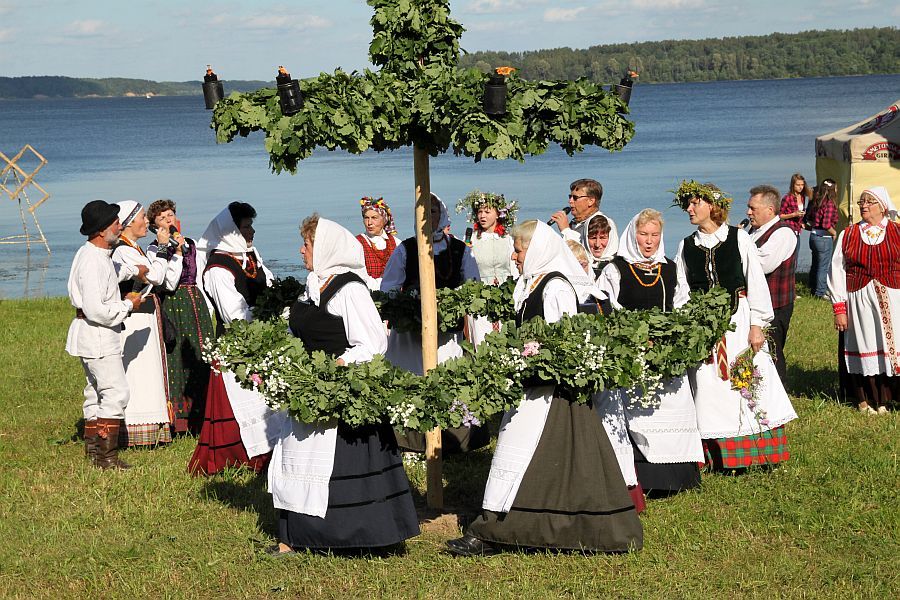
In many places of France, the people chose to have their bonfires near a chapel dedicated to St. John. These fires, which were ceremoniously blessed by the priest after Vespers, gave more grandeur to the practice. The Church encouraged parish priests in every country to process from hilltop to hilltop to light and bless all of the fires of the peasants in the countryside.
In the center of many of these bonfires was a tall tree trunk cut by the village men, decorated with wreaths and garlands, and erected ceremoniously. In upper Brittany, a boy named Jean or a girl named Jeanne would have the honor to make the grandest flower garland to crown the tree trunk.
Even Britton fishermen who were at sea had their own St. John's Fires in barrels filled with old clothing that hung from the main mast. A ceremony accompanied the lighting, with all the ships in a fleet lighting their fires at the same time as the sailors sang and prayed the ancient formulas.
In Norway and other places of northern Scandinavia, those who lived by the shore went out in boats beautifully decorated with flowers to watch the fires on the shore.
A time for celebration
Before the bonfire ceremony started, everyone gathered to have a grand picnic on the hillside or a feast in the town inn. In every country there was regional music, dancing and merriment as the people danced and sang round the "St. John's fire" wearing their finest traditional dress.
Jumping over the bonfire was thought to bring prosperity and blessings for the coming year. Some songs asked that the crops would grow as high as the young men jumped. At other places, a required number of jumps had to be met to bring blessings or protection from disease.
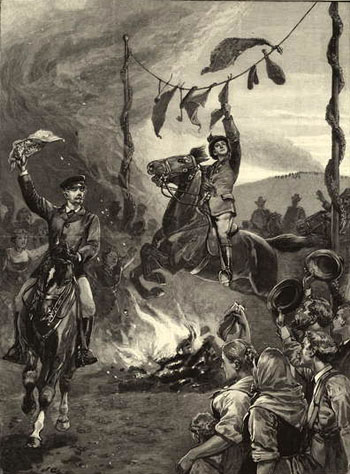
German youth claiming their prizes,
below, a Slavic lad jumps over the fire

Embers from the St. John's bonfire were saved and kept in a special place in the house to prevent a house or barn fire. In some places, the embers were sprinkled over the fields with prayers asking that God give good yields.
Since this feast occurs at the Midsummer between planting and harvest, it was a natural time for the peasants to break from the ardors of planting and harvesting. The first Summer fruits were brought to be eaten at picnics.
The Catholic peoples of old knew that the first fruits of each season should be harvested and used to honor God and His Saints and, indeed, it seemed as if God Himself had planned the seasonal harvest times to fall on the grand feasts of the Mystery of Salvation.
The shepherds celebrated this feast very merrily as St. John is the patron of shepherds because of his symbol, the lamb. Shepherds carried torches made of birch bark around their herds and sheepfolds to bring blessings on their flock. Afterwards, they set the torches on hills as they celebrated the feast.
In the Jura district of France, they placed wreaths of flowers on their sheep and processed them through the town; the wreaths were later placed on the stable doors for protection.
Reviving St. John's Eve customs
How good it would be if we were to revive this old custom of revering St. John with splendid celebrations! It would be a way to counter the pagans of our days who are using his feast day to make witchcraft and evil. It would not be difficult for families to collect sticks and old wood on the Eve of the feast (or weeks before) to build a large bonfire in a backyard or pasture. Perhaps in its center a large tree trunk or beam could be erected by the men and boys.
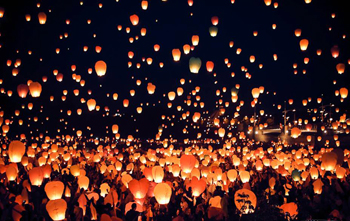
Lanterns released into the night sky in Poland, below, in Brazil hot balloons float over the cities
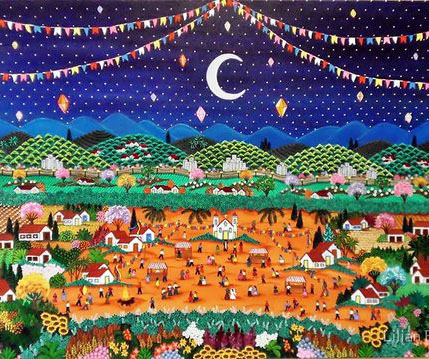
With all the modern regulations, a bonfire may not be possible. But a small fire could still be lit in a pit or grill, or candles and torches set up on a table or mound of dirt to light ceremoniously. Even these small fires can be beautifully adorned with garlands and wreaths, making a marvelous sight.
When evening draws near on St. John's Eve, let all don festive garments – preferably the regional traditional costumes – to add an elevated tone to the ceremony. Likewise, let the festive picnic – to include the fresh summer fruits such as strawberries, cherries, peaches and apricots – have a higher tone to honor St. John.
Here is a video of a Latvian celebration reviving the traditional customs. Unfortunately, not all are dressed as they should be and a casual tone enters, but other than that you could find some inspiration in their charming songs, dress, dance and decorations.
After the meal, the ceremony of lighting the bonfires takes place at sunset. Ideally a priest would bless the fire with the traditional blessing found in the Roman Missal, but today this would be difficult to do. So, let the head of the house bless the fire with holy water and read or chant the blessing, asking that God send blessings and protection to his household in these difficult days.
After the blessing, it is traditional to walk clockwise around the fire praying a decade of the rosary. Any worn out Sacramentals can then be thrown into this blessed fire at this time.
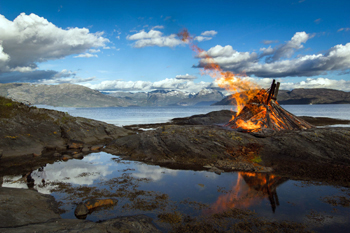
A grand bonfire seen for miles in Norway
If you have gardens, fields, or barns with livestock, a flaming torch from the fire can be carried through the fields and gardens to bring blessings. Embers and ashes of the blessed fire can be saved and kept in a safe place in the house or sprinkled in the fields or barns.
This is the time to gather the traditional herbs from the wild or your garden, especially St. John's Wort. These St. John's herbs can then be brought to church the next day and blessed by your priest, should you have the good fortune to have a pastor who supports the good customs of the past.
These little practices to honor the great St. John the Baptist truly bring blessings on households and families; the great Precursor of Christ will look down from Heaven with pleasure on our homage if we offer it with due pomp and ceremony.
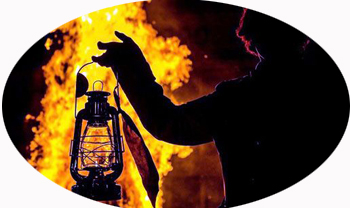
Lighting the flame of Cantigo

Posted June 22, 2020
______________________
______________________
 |
 |
 |
 |
 |
 |


